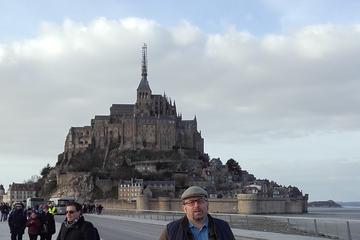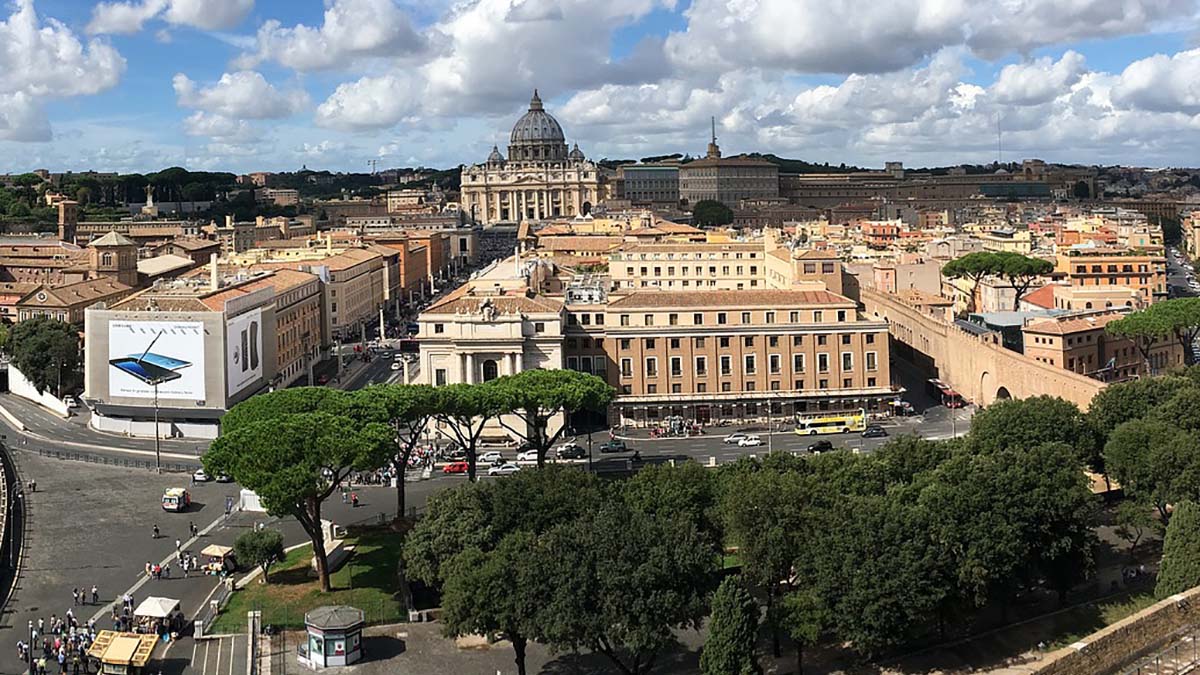
by Doris Gregory
On that stifling July day, the elevator was packed with hot, sweaty people. We had just come down, by spiral staircase and then the elevator, after viewing the Eternal City from the top of St. Peter’s.
The elevator door opened and the crowd surged past nine-year old Wayne, out into the corridor. My son just stood there, with a strange look on his face. “Come on, Wayne,” I ordered, “Move!” “I can’t,” he said. “My arm’s stuck!”
Evidently his arm had been resting on the elevator door. When the door opened and slid into its pocket, it had taken his arm with it.
The elevator operator shouted something in his native Italian and pulled Wayne’s arm free. Then he grabbed him by the other hand, muttered something like “dottoro” to me and the ticket taker outside, and then took off at top speed with Wayne, while I and Linda and Brian, my other two children, one on each side of me, ran behind. We had all we could do to keep up, but had a brief pause for breath when the man stopped at a drinking fountain with the comforting sign “Aqua Pura” and shoved Wayne’s gashed and bleeding hand into the water. Then on we raced down the corridor to a short wide flight of stairs leading to heavy double doors, fronted by two colourfully uniformed Swiss Guards. As we approached, our escort shouted something to them, they moved aside, and the doors flew open. On we rushed, down another long corridor, around a corner, then up one more short wide flight of stairs, where another set of Swiss Guards moved aside and one more pair of doors flew open. One last long corridor and we arrived at what appeared to be the infirmary.
The white-coated doctor shoved a printed sheet in front of me and handed me a pen. I didn’t know a word of Italian, other than “Parla Inglesi?” (to which his answer would obviously have been “no”) but assumed that this lengthy document was one absolving any responsibility of the Vatican for my son’s unhappy plight. I signed it “Can’t read a word of this Doris Gregory” all on one line, not that I had any hope of winning a lawsuit against the Vatican.
The good doctor washed and disinfected and bandaged the hand, after first pulling on the fingers to make sure nothing was broken, which fact he somehow communicated to me by pantomime. And then he held up a bottle labeled “tetano”, at the same time holding up four fingers of his other hand. Since the children and I had all had tetanus boosters just before leaving Canada, I nodded my head. At that time, the boosters were considered to last only four months.
I have absolutely no recollection of how we got out of that maze of corridors. Presumably the elevator operator had remained with us and escorted us back the way we had come.

Footnote: Wayne’s hand healed well and he grew up to be a surgeon.

Private Tour: Vatican Museum, Sistine Chapel and St Peters Basilica Guided Tour
If You Go:
ROME and VATICAN TOURS
VATICAN
About the author:
Doris Gregory was born in Vancouver, but spent almost half her life elsewhere, first as a Servicewoman in England during World War 2, then pursuing a career in psychology in the USA and Ontario. Now she is enjoying a happy retirement back in Vancouver, volunteering at Brock House and writing her war memoir, which she hopes to publish during the coming year.
Photo credit:
Image by Michael Siebert from Pixabay



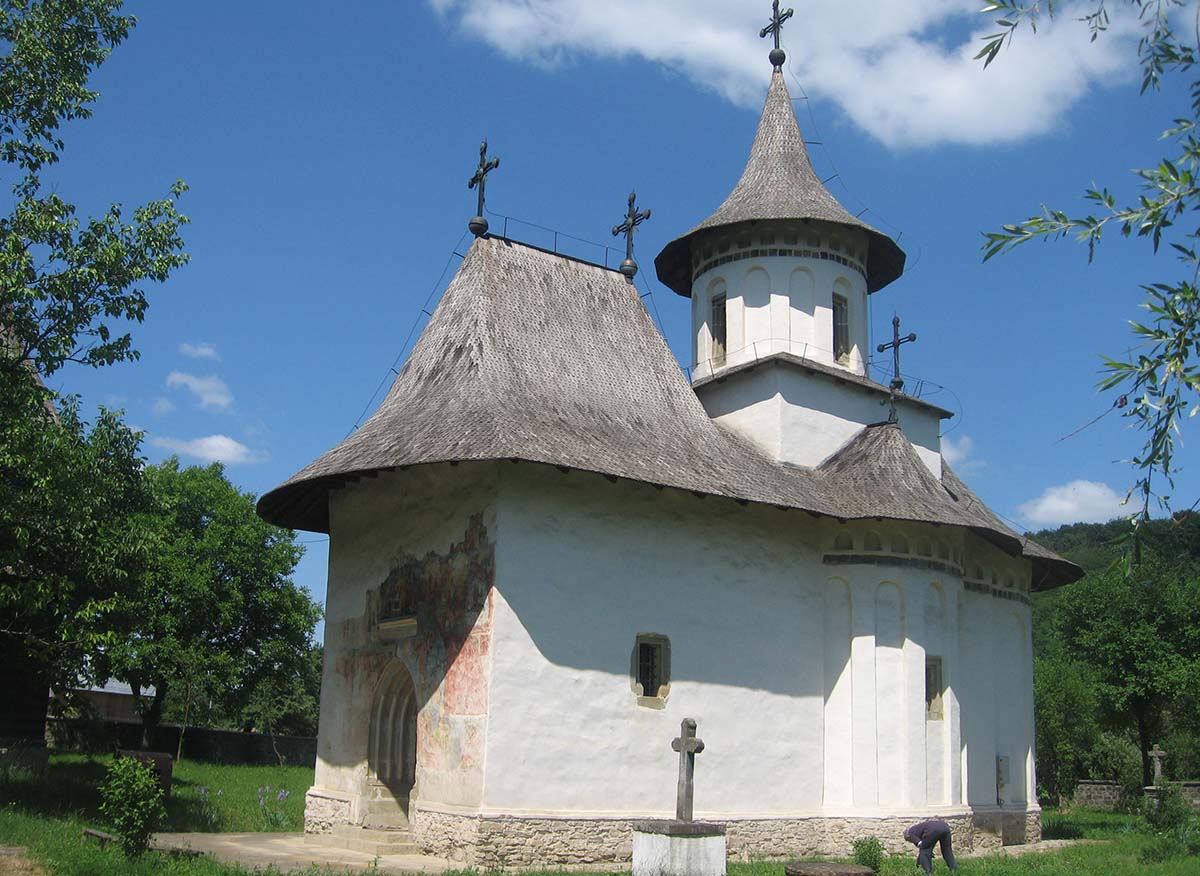

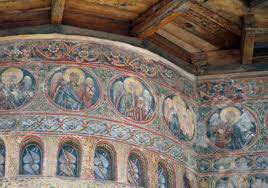 In the twenty-four years of my life I spent in Romania, I only once had the occasion to visit a unique region of Romania called Moldova and I was just nine years old then.
In the twenty-four years of my life I spent in Romania, I only once had the occasion to visit a unique region of Romania called Moldova and I was just nine years old then.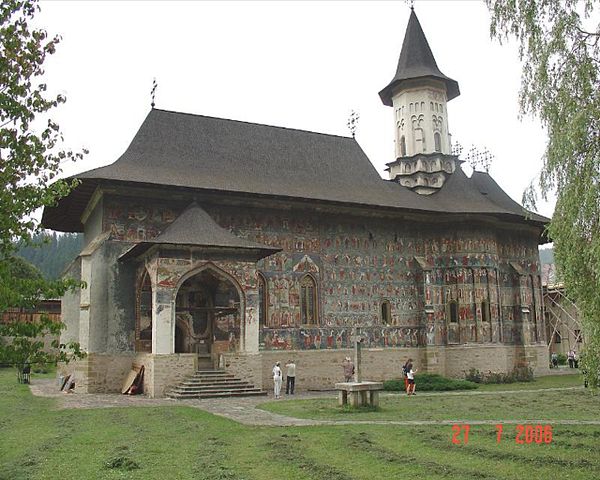 Entering the church, you are inclined to approach solemnly and humbly. Passing two separate stands that hold hundreds of thin yellow candles lit for the souls of the departed, you head slowly towards the altar, mesmerized by Byzantine-influenced icons and priests in holy attire. It was quite a thrill to be free to explore my own religion, free from the Communist regime which totally discouraged the population to go to church and believe in a higher power.
Entering the church, you are inclined to approach solemnly and humbly. Passing two separate stands that hold hundreds of thin yellow candles lit for the souls of the departed, you head slowly towards the altar, mesmerized by Byzantine-influenced icons and priests in holy attire. It was quite a thrill to be free to explore my own religion, free from the Communist regime which totally discouraged the population to go to church and believe in a higher power.
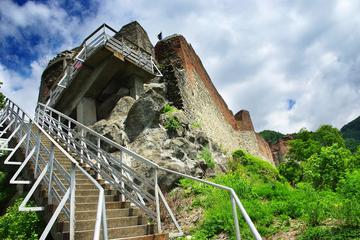

 Vis was christened Issa by 4th century BC Greek settlers. The town site and well-protected harbor of Vis, off the Croatian coast, was once the most powerful Greek colony in the Adriatic Sea, a city state with its own rulers and currency.
Vis was christened Issa by 4th century BC Greek settlers. The town site and well-protected harbor of Vis, off the Croatian coast, was once the most powerful Greek colony in the Adriatic Sea, a city state with its own rulers and currency.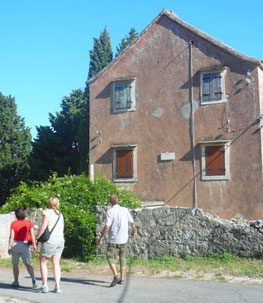 Our guide was Jurica Zitko, a community leader and paragliding instructor. Dimar, our driver, worked for the San Georgio Hotel where we were staying and just happened to have a Land Rover. Perfect!
Our guide was Jurica Zitko, a community leader and paragliding instructor. Dimar, our driver, worked for the San Georgio Hotel where we were staying and just happened to have a Land Rover. Perfect!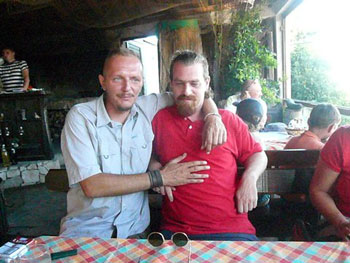 Today, the simple sign, “Tito’s Cave”, at the entrance, announces his former presence. About two hundred steps bring you to Tito’s meeting rooms; another hundred will take you to his living quarters. . Now, all we saw of past military occupation were a few strands of barbed wire, bent over by winds and neglect.
Today, the simple sign, “Tito’s Cave”, at the entrance, announces his former presence. About two hundred steps bring you to Tito’s meeting rooms; another hundred will take you to his living quarters. . Now, all we saw of past military occupation were a few strands of barbed wire, bent over by winds and neglect. No signs announced the remains of Fort St. George built by the British in 1813 to guard the harbor. After vanquishing Napoleon in 1815, they abandoned the Fort to the elements. Parts of it have crumbled, but most of it, including walls and cannons are still intact. We were the only people there. It seems commercialization has not yet taken hold.
No signs announced the remains of Fort St. George built by the British in 1813 to guard the harbor. After vanquishing Napoleon in 1815, they abandoned the Fort to the elements. Parts of it have crumbled, but most of it, including walls and cannons are still intact. We were the only people there. It seems commercialization has not yet taken hold.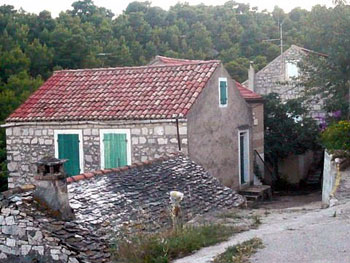 The inland villages, are very tiny—stone houses with red tile roofs surrounded by vineyards, olive trees and cattle. The vines wind around the hillside and over stone walls. It is totally unspoiled. Life revolves around wine, olive harvests, fishing and local festivals. Wild herbs, such as thyme, rosemary and lavender are hardy perennials.
The inland villages, are very tiny—stone houses with red tile roofs surrounded by vineyards, olive trees and cattle. The vines wind around the hillside and over stone walls. It is totally unspoiled. Life revolves around wine, olive harvests, fishing and local festivals. Wild herbs, such as thyme, rosemary and lavender are hardy perennials.
 Our headquarters, the San Giorgio Hotel in Kut, was a twenty-minute walk from Vis Town. It was July. Yachts pulled up and its occupants dined al fresco on the decks. Tourists can have their pick… sailing, snorkeling, and swimming. Not to mention exploring nearby coves and caves. (Sunken ships from the 1866 War are a great draw, also, subs and an airplane or two) Incredibly the water is so blue, you can almost see to the bottom. All the beaches are rocky, but no one seems to mind.
Our headquarters, the San Giorgio Hotel in Kut, was a twenty-minute walk from Vis Town. It was July. Yachts pulled up and its occupants dined al fresco on the decks. Tourists can have their pick… sailing, snorkeling, and swimming. Not to mention exploring nearby coves and caves. (Sunken ships from the 1866 War are a great draw, also, subs and an airplane or two) Incredibly the water is so blue, you can almost see to the bottom. All the beaches are rocky, but no one seems to mind.

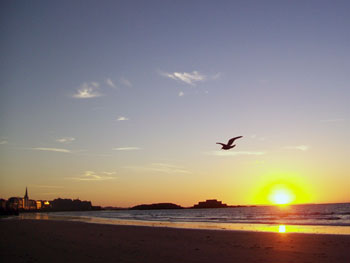 The ancient abbey rises out of sea and silt like the most triangular of mountains, seemingly balanced precariously on its rock without an inch of land wasted; and is big enough to be seen from the edge of its bay, over thirty kilometres (twenty miles) away. After I reached its public-access summit half way through my week-long holiday in France, Mont-St-Michel became the peak of my visit in more ways than one; a week that had started unplanned, and turned into an enjoyable trip down memory lane as well as one full of new sights.
The ancient abbey rises out of sea and silt like the most triangular of mountains, seemingly balanced precariously on its rock without an inch of land wasted; and is big enough to be seen from the edge of its bay, over thirty kilometres (twenty miles) away. After I reached its public-access summit half way through my week-long holiday in France, Mont-St-Michel became the peak of my visit in more ways than one; a week that had started unplanned, and turned into an enjoyable trip down memory lane as well as one full of new sights. I relived some of my traveling past by hiking about 10km from the airport to my hotel, on the southern edge of Saint-Malo. The local bus service does not cater for the airport. I crossed the Rance estuary below Saint-Servan, which was called Aleth when a Welsh monk called Maclow became its bishop in the 6th century. It was from Maclow that a new community to the north took its name; Saint-Malo has since incorporated Saint-Servan within its city boundaries. Brittany still has a Celtic identity.
I relived some of my traveling past by hiking about 10km from the airport to my hotel, on the southern edge of Saint-Malo. The local bus service does not cater for the airport. I crossed the Rance estuary below Saint-Servan, which was called Aleth when a Welsh monk called Maclow became its bishop in the 6th century. It was from Maclow that a new community to the north took its name; Saint-Malo has since incorporated Saint-Servan within its city boundaries. Brittany still has a Celtic identity.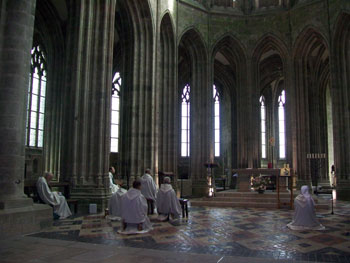 The next day I moved to Saint-Malo’s only hostel, which is ideally situated only two blocks from the Grand Plage: two miles of beach between the walled old town and the district of Parame. There hadn’t been any room at the hostel on the Saturday night. I spent the next couple of days getting to know the landmarks and beaches of Saint-Malo.
The next day I moved to Saint-Malo’s only hostel, which is ideally situated only two blocks from the Grand Plage: two miles of beach between the walled old town and the district of Parame. There hadn’t been any room at the hostel on the Saturday night. I spent the next couple of days getting to know the landmarks and beaches of Saint-Malo. At low tide you can walk out to Fort National, Île du Grand Bé and Fort du Petit Bé. The former was built during the reign of Louis XIV in the late 17th century, and was named Fort Royale until the French Revolution a century later. It is open to visitors during the summer. Malouin writer Chateaubriand, cited as the founder of French Romanticism, is buried on Île du Grand Bé; a hilltop cross marks the site, and views stretching for miles to the western edge of the bay explain its Romantic reason.
At low tide you can walk out to Fort National, Île du Grand Bé and Fort du Petit Bé. The former was built during the reign of Louis XIV in the late 17th century, and was named Fort Royale until the French Revolution a century later. It is open to visitors during the summer. Malouin writer Chateaubriand, cited as the founder of French Romanticism, is buried on Île du Grand Bé; a hilltop cross marks the site, and views stretching for miles to the western edge of the bay explain its Romantic reason. The cathedral is a central landmark and highlight, rising high above streets full of gift and clothes shops; crepe and seafood restaurants. Museums, a twentieth-century war memorial, and a central park are also of interest within the city walls; and regular plaques tell the historical significance of streets and buildings. Exiting the walls to the south, corsair sailing ships in the harbour are another reminder of the past.
The cathedral is a central landmark and highlight, rising high above streets full of gift and clothes shops; crepe and seafood restaurants. Museums, a twentieth-century war memorial, and a central park are also of interest within the city walls; and regular plaques tell the historical significance of streets and buildings. Exiting the walls to the south, corsair sailing ships in the harbour are another reminder of the past.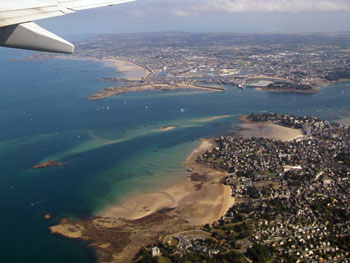 I took the coach from Saint-Malo to Mont-St-Michel at 9.15 the next morning. It is the only bus on that route, and a 20 Euros return ticket is required. The journey takes 75 minutes, and with the return leaving at 15.45 you have about five hours at the Mont. You cross from Brittany to Normandy on the journey.
I took the coach from Saint-Malo to Mont-St-Michel at 9.15 the next morning. It is the only bus on that route, and a 20 Euros return ticket is required. The journey takes 75 minutes, and with the return leaving at 15.45 you have about five hours at the Mont. You cross from Brittany to Normandy on the journey. There were grey skies when we arrived, but the view was still spectacular. I walked up the narrow winding streets crammed with shops and tourists to the abbey gift shop, where you buy a ticket to enter the abbey and highest tier possible. On the ascent, the causeway linking the Mont with the mainland stretches out to the south, between the grey silt of low tide sea and the green vegetation of natural land; dividing the bay arcing to the east and west. To the north there is only the abbey towering above you, crowned by a golden Saint Michel statue.
There were grey skies when we arrived, but the view was still spectacular. I walked up the narrow winding streets crammed with shops and tourists to the abbey gift shop, where you buy a ticket to enter the abbey and highest tier possible. On the ascent, the causeway linking the Mont with the mainland stretches out to the south, between the grey silt of low tide sea and the green vegetation of natural land; dividing the bay arcing to the east and west. To the north there is only the abbey towering above you, crowned by a golden Saint Michel statue.
